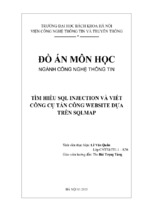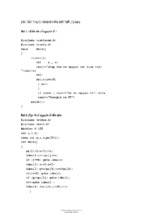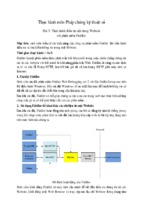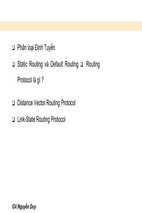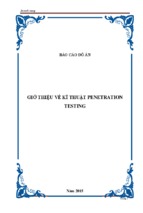Glossary
access control: Determining who or what can have access to what, and when
and how they can access it.
ACID: atomicity, consistency, isolation, and durability. These are the main
requirements for proper transaction processing.
API: application programming interface. A collection of subroutine calls that
allow computer programs to use a software system.
application hosting: It comes in several models. One model requires the
vendor to run an entire application for a customer. Software as a Service
(SaaS) is another form of application hosting.
architecture: In information processing, the design approach taken in developing a program or system.
archiving: The process by which a database or file data that is seldom used
or is outdated, but is required for historical or audit reasons, is copied to a
cheaper form of storage. The storage medium may be online, tape, or optical
disc.
ASP.NET: This is a Web application framework, from Microsoft, that programmers use to build Web applications and Web services. It’s versatile
because it allows programmers to write ASP.NET code using any supported
.NET language.
asset management: Software that allows organizations to record all information about their hardware and software. Most such applications capture cost
information, license information, and so on. Such information belongs in the
configuration management database. See also CMDB.
audit: A check on the effectiveness of a task or set of tasks and how the tasks
are managed and documented.
audit trail: A trace of a sequence of events in a clerical or computer system.
This audit usually identifies the creation or modification of any element in
the system, who did it, and (possibly) why it was done.
276
Cloud Computing For Dummies
authentication: The process by which the identity of a person or computer
process is verified.
AWS: Amazon Web Services. The set of Web services that Amazon offers to
help Web developers build Web applications and use Amazon’s cloud computing environment.
Azure: Windows Azure is an operating system for cloud computing from
Microsoft. The hosting and management environment are maintained
at Microsoft data centers, so there’s no need to use internal data center
resources when developing applications in Azure.
backup: A utility that copies databases, files, or subsets of databases and
files to a storage medium. This copy can be used to restore the data in case
of serious failure.
bandwidth: Technically, the range of frequencies over which a device can
send or receive signals. The term is also used to denote the maximum data
transfer rate, measured in bits per second (bps), that a communications
channel can handle.
Basel II: Known more formally as the International Convergence of Capital
Measurement and Capital Standards — A Revised Framework. Basel II is an
internationally recognized set of rules for evaluating a bank’s finances in light
of various risks. It’s also one of the big compliance regulations making organizations do things that they wouldn’t otherwise feel compelled to do. (Basel,
by the way, is named after a very lovely city in Switzerland.)
batch: A noninteractive process that runs in a queue, usually when the
system load is lowest; generally used for processing batches of information
in a serial and usually efficient manner. Early computers were capable of only
batch processing.
best practice: An effective way of doing something. It can relate to anything
from writing program code to IT governance.
binding: Making the necessary connections among software components so
that they can interact.
biometrics: Using a person’s unique physical characteristics to prove his
identity to a computer — by a fingerprint scanner or voice analyzer, for
example.
black box: A component or device with an input and an output whose inner
workings need not be understood by or accessible to the user.
Glossary
BPaaS: Business Process as a Service. A whole business process is provided
as a service involving little more than a software interface, such as a parcel
delivery service.
BPEL: Business Process Execution Language. A computer language based on
WSDL (Web Services Description Language, an XML format for describing
Web services) and designed for programming the orchestration of business
services. See also XML.
BPM: business process management. A technology and methodology for
controlling the activities — both automated and manual — needed to make a
business function.
broker: In computer programming, a program that accepts requests from
one software layer or component and translates them into a form that can be
understood by another layer or component.
browser: A program that lets you access information on the Internet.
Browsers are on computers, cellphones, and personal digital assistants, and
soon will appear on refrigerators.
bus: A technology that connects multiple components so they can talk to one
another. In essence, a bus is a connection capability. A bus can be software
(such as an enterprise service bus) or hardware (such as a memory bus). See
also ESB.
business process: The systematic arrangement of rules and practices that
constitute a business.
business process modeling: A technique for transforming how business operates into a systematic arrangement of source in code so that it can be translated into software.
business rules: Constraints or actions that refer to the actual commercial
world but may need to be encapsulated in service management or business
applications.
business service: An individual function or activity that is directly useful to
the business.
center of excellence: A group of key people from all areas of the business
and operations that focuses on best practices. A center of excellence provides a way for groups within the company to collaborate. This group also
becomes a force for change, as it can leverage its growing knowledge to help
business units benefit from experience.
277
278
Cloud Computing For Dummies
change management: The management of change in operational processes
and applications.
client/server: A model of computing in which the various processes are classified as either consumers of services (clients) or providers of services (servers).
This classification was once used as the basis for dividing processes among the
available processors.
cloud computing: A computing model that makes IT resources such as servers, middleware, and applications available over the Internet as services to
business organizations in a self-service manner.
CMDB: configuration management database. In general, a repository of service management data. See also repository.
CMMI: Capability Maturity Model Integration. A process-improvement best
practice used to improve processes in a project or overall. The Software
Engineering Institute of Carnegie Mellon University, along with representatives of industry and government, developed CMMI.COBIT: Control
Objectives for Information and Related Technology. An IT framework with a
focus on governance and managing technical and business risks.
component: A piece of computer software that can be used as a building
block in larger systems. Components can be parts of business applications
that have been made accessible through Web service-related standards and
technologies. See also Web service.
compute unit: Within its EC2 service, Amazon uses computer units to measure the infrastructure used by virtual server instances. Currently, one EC2
Compute Unit provides the equivalent CPU capacity of a 1.0–1.2 GHz 2007
Opteron or 2007 Xeon processor. Other IaaS providers also have units for
measuring resource usage.
configuration: The complete description of the way in which the constituent
elements of a software product or system interrelate, both in functional and
physical terms.
configuration management: The management of configurations, normally
involving holding configuration data in a database so that the data can be
managed and changed where necessary.
container: In computer programming, a data structure or object used to
manage collections of other objects in an organized way.
CRM: customer relationship management. Software intended to help you run
your sales force and customer support operations.
Glossary
data cleansing: Software used to identify potential data-quality problems. If
a customer is listed multiple times in a customer database due to variations
of the spelling of her name, the data-cleansing software makes corrections to
help standardize the data.
data fabric: The part of the computer network devoted to transmissions.
data federation: Data access to a variety of data stores, using consistent
rules and definitions that enable all the data stores to be treated as a single
resource.
data profiling: A technique or process that helps you understand the content, structure, and relationships of your data. This process also helps you
validate your data against technical and business rules.
data quality: Characteristics of data such as consistency, accuracy, reliability, completeness, timeliness, reasonableness, and validity. Data-quality software ensures that data elements are represented in a consistent way across
different data stores or systems, making the data more trustworthy across
the enterprise.
data transformation: A process by which the format of data is changed so it
can be used by different applications.
data warehouse: A large data store containing the organization’s historical
data, which is used primarily for data analysis and data mining.
database: A computer system intended to reliably store lots of information
in an organized way. Most databases provide users convenient access to the
data, along with helpful search capabilities.
dedicated hosting: Dedicated hosting is where the customer is given full control over the server that is hosted in the cloud. This contrasts with managed
hosting, where management is the responsibility of the hosting company.
dedicated server: A dedicated server is one the customer does not share
with any other users of the hosting cloud service.
directory: The word is used in both computing and telephony to indicate an
organized map of devices, files, or people.
distributed processing: Spreading the work of an information processing
application among several computers.
early binding: Making necessary connections among software components
when the software system is built.
279
280
Cloud Computing For Dummies
EC2: Elastic Compute Cloud from Amazon. This is Amazon’s commercial
Infrastructure as a Service (IaaS) Web service that has pioneered cloud
computing.
elasticity: The ability to expand or shrink a computing resource in real time,
based on need.
ERP: Enterprise Resource Planning. A packaged set of business applications
that combines business rules, process, and data management into a single
integrated environment to support a business.
ESB: enterprise service bus. A distributed middleware software system that
allows computer applications to communicate in a standardized way.
eSCM: eSourcing Capability Model. A framework developed at Carnegie
Mellon University to provide a best-practices model for improving relationships between customers and suppliers in outsourcing agreements.
ETL: Extract — Transform — Load. Tools for locating and accessing data
from a data store (data extraction), changing the structure or format of the
data so it can be used by the business application (data transformation), and
sending the data to the business application (data load).
eTOM: enhanced Telecom Operations Map. A framework that provides a
business process model for the telecommunications industry.
fault tolerance: The ability of a system to provide uninterrupted service
despite the failure of one or more of the system’s components.
federation: The combination of disparate things so that they can act as one —
as in federated states, data, or identity management — and making sure that all
the right rules apply.
framework: A support structure for developing software products.
GPL: GNU General Public License. An open-source copyright license created
by Richard Stallman that, in its strictest form, requires programs built on
code licensed under GPL to adopt the same license.
granularity: An important software design concept, especially in relation to
components, referring to the amount of detail or functionality — from fine to
coarse — provided in a service component. One software component can do
something quite simple, such as calculate a square root; another has a great
deal of detail and functionality to represent a complex business rule or workflow. The first component is fine grained, and the second is coarse grained.
Developers often aggregate fine-grained services into coarse-grained services
to create a business service.
Glossary
grid computing: A step beyond distributed processing, involving large numbers of networked computers (often geographically dispersed and possibly of
different types and capabilities) that are harnessed to solve a common problem. Clouds are usually organized as a computer grid.
HIPAA: Health Insurance Portability and Accountability Act of 1996. A set
of extensive regulations that healthcare organizations and providers in
the United States must follow. One of the goals is to control the healthcare
system to protect patients’ right to privacy regarding information about their
health. The policies and regulations place significant demands on technology
systems that have anything to do with healthcare.
HTML: Hypertext Markup Language. A data-encoding scheme invented by
Tim Berners-Lee in 1991 and the basic way that information is encoded over
the World Wide Web.
HTTP: Hypertext Transport Protocol. The basic way that information is
linked and transmitted over the World Wide Web. HTTPS is a version of
HTTP with encryption for security.
IaaS: Infrastructure as a Service. Infrastructure, including a management
interface and associated software, provided to companies from the cloud as
a service.
identity management: Keeping track of a single user’s (or asset’s) identity
throughout an engagement with a system or set of systems.
information integration: A process using software to link data sources in
various departments or regions of the organization with an overall goal of
creating more reliable, consistent, and trusted information.
infrastructure: The fundamental systems necessary for the ordinary operation of an IT department. In IT, infrastructure includes basic computer
hardware, networks, operating systems, storage, and other software that
applications run on top of.
infrastructure services: Services provided by the infrastructure. In IT, these
services include all the software needed to make devices talk to one another,
for starters.
Internet: A huge computer network linking almost all the computers in the
world and enabling them to communicate via standard protocols (TCP/IP)
and data formats. See also SMTP, TCP/IP, and XML.
interoperability: The ability of a product to interface with many other products; usually used in the context of software.
281
282
Cloud Computing For Dummies
IP: Internet Protocol. A systematic technique for communicating data across
a packet-switched network. IP can also mean intellectual property such as
patents, trademarks, copyrights, and trade secrets. See also TCP/IP.
ISO: International Organization for Standardization. An organization that has
developed more than 17,000 international standards, including standards for
IT service management and corporate governance of information technology.
ITIL: Information Technology Infrastructure Library. A framework and set of
standards for IT governance based on best practices.
JCA: J2EE Connector Architecture. A technology that enables Java programs
to talk to other software, such as databases and legacy applications.
key performance indicator: KPI. An indicator used to measure the effectiveness of a process.
LAMP: An increasingly popular open-source approach to building Web
applications. LAMP comprises the Linux operating system, the Apache Web
server, a MySQL database, and a scripting language (such as PHP, Perl, or
Python).
late binding: Deferring the necessary connections among applications to when
the connection is first needed. Late binding allows more flexibility for changes
than early binding does, but it imposes some cost in processing time.
legacy application: Any application more than a few years old. When applications can’t be disposed of and replaced easily, they become legacy applications.
The good news is that they’re still doing something useful when selected pieces
of code can be turned into business services with new standardized interfaces.
Linux: Linux is an open-source operating system based upon and similar
to Unix. In cloud computing it is the dominant operating system, primarily
because there are no license fees for Linux.
Linux Web hosting: The vast majority of Web sites run on the Linux operating system managed by a Linux Web hosting service using the LAMP (Linux,
Apache, MySQL, PHP) software stack.
loose coupling: An approach to distributed software applications in which
components interact by passing data and requests to other components in
a standardized way that minimizes dependencies among components. The
emphasis is on simplicity and autonomy. Each component offers a small
range of simple services to other components.
Glossary
malware: The general term for computer software that intentionally does ill,
such as viruses, Trojans, worms, and spyware.
managed hosting: This is where the customer gives control of his leased
server to the managed hosting service, which then provides a guaranteed
quality of service. See also dedicated hosting.
markup language: A way of encoding information that uses plain text containing special tags often delimited by angle brackets (< and >). Specific
markup languages are often created, based on XML, to standardize the interchange of information between different computer systems and services. See
also XML.
mashup: A program (possibly installed on a Web page) that combines content from more than one source, such as Google Maps and a real-estate listing service.
master-slave: An arrangement in which one system or process is designated
as a controller and other participating systems or processes respond to this
controller. Should a master fail, the slaves are unable to continue.
metadata: The definitions, mappings, and other characteristics used to
describe how to find, access, and use the company’s data and software
components.
metadata repository: A container of consistent definitions of business data
and rules for mapping data to their actual physical locations in the system.
middleware: Multipurpose software that lives at a layer between the operating system and application in distributed computing environments.
mission critical: Something, such as an application, that a business cannot
afford to be without at any time.
MOM: message-oriented middleware. A precursor to the enterprise service
bus. See ESB.
multi-tenancy: This refers to the situation where a single instance of an application runs on a SaaS vendor’s servers, but serves multiple client organizations (tenants), keeping all their data separate. In a multi-tenant architecture,
a software application partitions its data and configuration so that each customer has a customized virtual application instance.
MySQL: An open-source option for relational databases.
283
284
Cloud Computing For Dummies
.NET: Pronounced dot-net; the latest Microsoft programming framework, with
heavy emphasis on Web services. See also Web service.
.NET Framework: In the cloud, the .NET Framework has become a key foundational component of Microsoft’s Azure platform for cloud computing.
network: The connection of computer systems (nodes) by communications
channels and appropriate software.
OASIS: Organization for the Advancement of Structured Information
Standards. A consortium promoting e-business and Web services standards.
open source: A movement in the software industry that makes programs
and the source code used to create them freely available so that others can
inspect and modify how they work.
P2P: peer to peer. A networking system in which nodes in a network
exchange data directly instead of going through a central server.
PaaS: Platform as a Service. This is a cloud service that not only includes
infrastructure (that is, hardware and operating software) but also a development environment and possibly other software development lifecycle tools.
Perl: Practical Extraction and Report Language. A powerful scripting language in widespread use in system administration, Web development, and
other activities.
PHP: PHP Hypertext Processor. An open-source scripting language (originally
designed in Perl) used especially for producing dynamic Web pages.
portal: In computing, a window that contains a means of access, often a menu,
to all the applications throughout the whole network that the user is able to
run. Often, the window is segmented into smaller windows, or portlets, that provide direct access to applications such as stock-market price feeds or email.
private cloud: As opposed to a public cloud, which is generally available,
a private cloud is a set of computing resources within the corporation that
serves only the corporation, but which is set up to operate in a cloudlike
manner as regards its management.
programming in the large: An approach to developing business software
that focuses on the various tasks or business processes needed to make the
business function — processing an order, for example, or checking product
availability — as opposed to low-level technical tasks such as opening a file.
Glossary
protocol: A set of rules that computers use to establish and maintain communication among themselves.
provisioning: Making resources available to users and software. A provisioning system makes applications available to users and makes server resources
available to applications.
real time: A form of processing in which a computer system accepts and
updates data at the same time, feeding back immediate results that influence
the data source.
real-time event processing: A class of applications that demand timely
response to actions that take place out in the world. Typical examples
include automated stock trading and radio frequency identification (RFID).
See also RFID.
registry: A single source for all the metadata needed to gain access to a Web
service or software component.
repository: A database for software and components, with an emphasis on
revision control and configuration management (where they keep the good
stuff, in other words).
response time: The time from the moment at which a transaction is submitted by a user or an application to the moment at which the final result of that
transaction is made known to the user or application.
RFID: radio frequency identification. A technology that uses small, inexpensive
chips attached to products (or even animals) that then transmit a unique identification number over a short distance to a special radio transmitter/receiver.
RPC: remote procedure call. A way for a program running on one computer
to run a subprogram on another computer.
Ruby on Rails: Ruby is a programming language, and Rails is a Ruby framework built specifically for Web applications. It is regarded as an efficient language for programming Web applications.
SaaS: Software as a Service. This self-service application is based on a cloud
infrastructure.
SAML: A standard framework for exchanging authentication and authorization information (that is, credentials) in an XML format called assertions.
285
286
Cloud Computing For Dummies
Sarbanes-Oxley: The Public Company Accounting Reform and Investor
Protection Act of 2002, a U.S. law enhancing standards for all U.S. public
companies’ boards of directors, resulting in substantial new requirements for
corporate IT.
scalability: Regarding hardware, the ability to go from small to large amounts
of processing power with the same architecture. Regarding software products such as databases, it refers to the consistency of performance per unit
of power as hardware resources increase.
scripting language: A computer programming language that is interpreted
and has access to all or most operating-system facilities. Common examples
include Perl, Python, Ruby, and JavaScript. It is often easier to program in
a scripting language, but the resulting programs generally run slower than
those created in compiled languages such as C and C++.
secure Web hosting: This Web hosting environment is made secure by the
use of Secure Socket Layer (SSL) certificates and HTTPS.
semantics: In computer programming, what the data means as opposed to
formatting rules (syntax).
server array: This is a collection of single server types that is normally used
for horizontal scaling. Typically, most private and public clouds are built as
server arrays and managed with virtualization software.
server farm: A facility filled with computer servers, often needed to run large
Internet sites.
service: A purposeful activity carried out for the benefit of a known target.
Services are often made up of a group of component services, some of which
may also have component services. Services always transform something,
and they complete by delivering an output.
service catalog: A directory of IT services provided across the enterprise,
including information such as service description, access rights, and
ownership.
service desk: A single point of contact for IT users and customers to report
any issues they may have with the IT service (or, in some cases, with IT’s
customer service).
service level agreement: SLA. A document that captures the understanding
between a service user and a service provider as to quality and timeliness.
Glossary
service management: Monitoring and optimizing a service to ensure that it
meets the critical outcomes that the customer values and the stakeholders
want to provide.
servlet: A program that runs on a Web server in response to an action taken
by the user via a browser.
silo: In IT, an application with a single narrow focus, such as human
resources management or inventory control, with no intention or preparation
for use by others.
silver bullet: A proposed solution that seems too good to be true and
usually is.
Simple Storage Service: S3. This distributed storage service, from Amazon,
constitutes part of AWS. Amazon provides the capability to read, write, and
delete objects (of data) that are up to 5 gigabytes in size. This isn’t a database capability — just a place to store and access files.
Six Sigma: A statistical term meaning six standard deviations from the norm.
Also the name of a quality-improvement program that aims at reducing
errors to one in a million.
SMTP: Simple Mail Transfer Protocol. The basic method used to transmit
e-mail over the Internet.
SOA: service-oriented architecture. An approach to building applications that
implements business processes or services by using a set of loosely coupled
black-box components orchestrated to deliver a well-defined level of service.
SQL: Structured Query Language. The most popular computer language for
accessing and manipulating databases.
SSL: Secure Sockets Layer. A popular method for making secure connections
over the Internet, first introduced by Netscape.
standards: A core set of common, repeatable best practices and protocols that have been agreed on by a business or industry group. Typically,
vendors, industry user groups, and end users collaborate to develop standards based on the broad expertise of a large number of stakeholders.
Organizations can leverage these standards as a common foundation and
innovate on top of them.
subroutine: A piece of computer code that can easily be used (called) by
many other programs, as long as they are on the same computer and (usually) are written in the same programming language.
287
288
Cloud Computing For Dummies
TCP/IP: Transmission Control Protocol/Internet Protocol. The complex stack
of communications protocols that underlies the Internet. All data is broken
into small packets that are sent independently over the network and reassembled at the final destination.
thin client: Client hardware in the client/server environment that is dependent on the server for loading applications. Most hardware designed for this
purpose is similar to a cut-down PC, with no floppy disk drive or hard drive.
throughput: The rate at which transactions are completed in a system.
TLS: Transport Layer Security. A newer name for SSL. See also SSL.
TQM: Total Quality Management. A popular quality-improvement program.
transaction: A computer action that represents a business event, such as
debiting an account. When a transaction starts, it must either complete or
not happen at all.
UDDI: Universal Description, Discovery, and Integration. A platform-independent, XML-based services registry sponsored by OASIS. See also OASIS and
XML.
virtualization: Technically, virtualization is emulation. Virtual memory is the
use of a disk to store active areas of memory to make the available memory
appear larger. In a virtual environment, one computer runs software that
allows it to emulate another computer. This kind of emulation is commonly
known as virtualization.
VMware: VMware provides the technology, which currently dominates the
virtualization of servers. In the cloud, however, the Xen hypervisor is also
widely used as it is open source.
VPS: virtual private server. This is a virtual server that is dedicated to a
single customer, whereas the server it resides on is actually shared among
several customers, who are completely unaware of each other. Each VPS
runs its own operating system, bandwidth, and disk space, and can be individually booted.
W3C: World Wide Web Consortium. An organization that coordinates standards for the World Wide Web.
Web service: A software component created with an interface consisting
of a WSDL definition, an XML schema definition, and a WS-Policy definition.
Collectively, components could be called a service contract — or, alternatively, an API. See also API, WSDL, WS-Policy, and XML.
Glossary
workflow: This sequence of steps carries out a business process. Workflow
technology automates the passage of information between the steps.
World Wide Web: A system built on top of the Internet that displays hyperlinked pages of information that can contain a wide variety of data formats,
including multimedia.
WSCI: Web Services Choreography Interface. An XML-based interface description language that describes the flow of messages exchanged by a Web Service
when it participates in choreographed interactions with other services.
WSDL: Web Services Definition Language. An XML format for describing
Web services.
WS-Policy: The Web Services Policy Framework, which provides a means of
expressing the capabilities, requirements, and characteristics of software
components in a Web services system.
WSRP: Web Services for Remote Portlets. A protocol that allows portlets to
communicate by using standard Web services interfaces.
XML: eXtensible Markup Language. A way of presenting data as plain-text
files that has become the lingua franca of SOA. In XML, as in HTML, data is in
tags that are enclosed in angle brackets (< and >), although the tags in XML
can have many more meanings. See also SOA.
XML schema: A language for defining and describing the structure of XML
documents.
XSD: XML schema definition. The description of what can be in an XML
document.
XSLT: eXtensible Stylesheet Language Transformations. A computer language, based on XML, that specifies how to change one XML document into
another. See also XML.
289
290
Cloud Computing For Dummies
Index
•A•
abstraction, 68
abstraction layer, 203–204
Accenture company, 99
access control
comprehensive security importance, 34
data management, 79
defined, 275
scheduling access, 199
security, 219
account and billing management
automation, 32
billing service, 235
potential problem with, 32
accounting, 157
ACID (automicity, consistency, isolation,
and durability), 275
activity log, 183
ad-hoc workload, 112
administration, security, 181
allocation cost, 251–252
Amazon
EBS (Elastic Block Store), 103, 111
EC2 (Elastic Compute Cloud), 109–113
SimpleDB database, 83
S3 (Simple Storage Service), 103, 111
Virtual Private Cloud, 91
Web site, 13
Amazon Work Space (AWS), 91, 276
amortization, 51
anchored lifecycle platform, 122
Apache Hadoop open-source distributed
platform, 82
Apex programming language, 129
API (application programming interface)
data transformation issue, 33
defined, 275
managing multiple, 33
overview, 11
REST, 132
standardized, 33
well-planned workload service, 68–69
AppJect company, 21
application
business process, 158
data architecture and, 33
incident and problem management, 239
monitoring, 217
virtualization, 198
application hosting, 275
application programming interface. See API
Application Service Provider (ASP), 21
AppLogic 3Tera company
as IaaS company, 115
private cloud offering, 102–103
architecture do’s and don’ts, 272
archive
cost, 249
data management, 84
defined, 275
ARTS (Association for Retail Technology
Standard), 170
ASP (Application Service Provider), 21
ASP.NET, 275
assertion, 285
asset management
asset register, 216
capacity planning, 73
defined, 275
desktop management, 216
license, 217
remote management, 217
service management, 37
workload, 73
asset performance, 30
Association for Retail Technology Standard
(ARTS), 170
Atom Publishing Protocol, 164
Atom Syndication Format, 164
atomicity, consistency, isolation, and
durability (ACID), 275
attack. See security
audit
data audit product, 184
defined, 275
risk, 192
292
Cloud Computing For Dummies
audit trail, 275
authentication
comprehensive security importance, 34
defined, 276
identity management, 180
authorization, 34
automation
application, 22
backup, 217
Runbook, 73
security, 219
availability risk, 192, 259
AWS (Amazon Work Space), 91, 276
Azure (Microsoft), 125–126, 276
•B•
backup
automated, 217
as business process, 159
cloud data center, 62
cost, 64, 249
data management, 79
defined, 276
traditional data center, 62
bandwidth
defined, 276
ensuring performance level, 241
performance management, 36
Basel II, 276
batch, 276
best practice. See also standard
about this book, 1
avoiding mistake through, 162
basic description of, 161
consulting practice, 162
defined, 276
independent book, 162
industry organization, 162
training material, 162
Bigtable database (Google), 83
billing and account management
automation, 32
billing service, 235
potential problem with, 32
billing and metering of service, 11
billing risk, 192
binding, 276
biometric, 276
black-box, 222, 276
blade cabinet, 212
Bloor, Robin (Service Oriented Architecture
For Dummies), 32
BPEL (Business Process Execution
Language), 277
BPM (business process management),
223, 277
breach, security, 177–178
broker, service, 224, 277
browser, 277
building cost, 58
bus, 277
business agility support, 15
business leader, 8
business management, 9
business process
accounting capability, 157
application, 158
backup and disaster recovery, 159
clerical activity, 159
collaboration, 159
communication, 159
computer-dependent, 29
defined, 277
do’s and don’ts, 272
email, 157
future of, 159
molecular modeling program, 157
monitoring, 29
payment technology, 159
research, 159
as service, 28, 155
Web site work, 159
Web-based, 159
Business Process Execution Language
(BPEL), 277
business process management (BPM),
223, 277
business process modeling, 277
business rule, 277
business service, 226–227
Business Week Magazine (Computing
Heads for the Clouds), 50
Index
•C•
CA company
eHealth Performance Manager
product, 101
private cloud offering, 100–101
Spectrum Automation Manager
product, 101
Spectrum Infrastructure Manager
product, 101
Canonical Web site, 214
Capability Maturity Model Integration
(CMMI), 278
capacity planning
asset management, 73
service management, 37
virtualization, 203
capital expenditure
private cloud, 92–93
reduction, 15
capital investment, 30, 246–247
CCIF (Cloud Computing Interoperability
Forum), 169–170
center of excellence, 277
change management
configuration management, 218
data management, 79
defined, 278
desktop management, 216
hardware provisioning, 218
patch management, 218
software distribution and upgrade, 218
support desk, 239
Cisco Webex Collaboration company, 148
Citrix GotoMeeting company, 148
clerical activity, 159
client
caching, 65
thin, 210, 288
virtualization, 210–212
client desktop, 210–212
client/server, 278
cloud
defining the, 9
leveraging the, 262–263
open, 165
participant, 9
trusted, 116–117
cloud computing evolution, 8–9
Cloud Computing Interoperability Forum
(CCIF), 169–170
cloud data center
backup, 62
cost to operate, 51–52
hardware cost, 60–61
traditional data center cost comparison,
55–58
cloud database, 83
cloud ecosystem, 33
cloud resource management. See resource
management
Cloud Security Alliance (CSA), 166–167, 269
cloud service. See also service
administering, 30–32
advantages of, 14–15
APIs, 11
billing and metering of service, 11
business agility support, 15
business drivers for consuming, 14–15
capital expenditure reduction, 15
characteristic, 10
defined, 9
delivery model, 17–18
elasticity characteristic, 10
free, 11
as important value to company, 9
multi-tenancy, 9
performance monitoring and
measurement, 12
scalability characteristic, 10
self-service provisioning characteristic,
10–11
social network, 9
cloud service provider
as cloud participant, 9
customer, 234–235
evaluation of, 31
having more than one, 31
investigating reliability and viability of,
30–31
IT service provider comparison, 12–14
management service type, 233
managing multiple, 233–234
responsibilities of, 232–233
roles of, 13
Cloud Standards Wiki, 269
293
294
Cloud Computing For Dummies
cloud washing, 94
CloudCamp Web site, 268
cluster, 82
clustering, 204
CMDB (Configuration Management
Database)
defined, 278
hybrid environment, 236
optimization, 65
virtualization, 202
CMMI (Capability Maturity Model
Integration), 278
CODA software company, 145
collaboration
as business process, 159
defining the cloud, 9
collaboration as a service, 146, 148–149
communication
as business process, 159
unified, 148
communications cost, 64
compatibility testing, 149
compliance
cost, 252–253
data management, 43, 85
risk, 192
as a service, 151
component, 278
composite application, 120
comprehensive strategy, 28
compute cycle, 15
compute unit, 110, 278
Computer Sciences Corporation (CSC),
98–99
computer-dependent business process, 29
computing cost, 52
Computing Heads for the Clouds (Business
Week Magazine), 50
Concur company, 147
configuration management
change management, 218
defined, 278
incident and problem management, 239
service management, 37
workload, 74
Configuration Management
Database (CMDB)
defined, 278
hybrid environment, 236
optimization, 65
virtualization, 202
connectivity, 241
Constant Contact company, 147
consultant, security, 185
consulting practice, 162
container, 278
container workload, 71
continuity plan, data management, 85
contract. See also SLA
data management, 85
risk, 192
termination, 85
cooling cost, 61
cost
allocation, 251–252
archive and backup, 249
asset management, 217
backup, 64
building, 58
cloud and traditional data center
comparison, 55–58
cloud computing economies of scale, 53
communications, 64
compliance, 252–253
computing, 52, 54
cooling, 61
data center operation, 50–51, 249, 251
disaster recovery, 64, 249
economic cost model, 253–254
electric power, 57
hardware, 60–63
heating and air, 58
help desk support, 250
infrastructure software, 250
in-house software, 249
investment incentive and taxation, 58
labor, 52, 56
land, 58
location, 58
network, 248–250
operational support, 250–251
package software, 249, 251
platform, 249, 251
power distribution and cooling, 52
private cloud versus allocation, 251–252
recovering, 250–251
revenue model, 143–144
security, 65
- Xem thêm -








